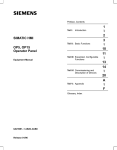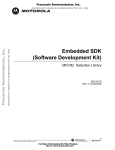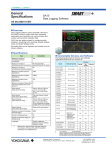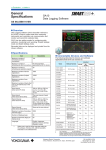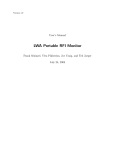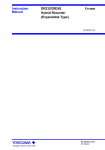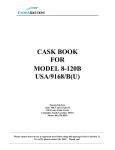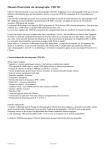Download 1 Function description
Transcript
1 Overview 1 Function description 1.1 Function overview The OP 2 is an operator control device for the SIMADYN D system. It offers the following performance scope: Siemens AG 465 981.7101.23 SIMADYN D STRUC G User manual Edition 02.96 1 ---1 1 Overview Data processing, refer to Section 1.2 VAL Displays and processes up to 24 pieces of process data. 2 pieces of process data are always displayed. BIN Displays and processes up to 32 binary values. Binary value processing, Message system refer to Section 1.3 refer to Section 1.4 MSG Autonomous message system for P16 --- and P32 messages. Messages are stored, sorted according to the time that they were received and can be deleted and printed. Only one message is displayed at any one time (max. 80 characters). SYS MSG System message refer to Section 3 System operation refer to Section 1.5 SYSTEM Changes and stores and basic function SIMADYN OP 2 SIEMENS Two- line display 40 characters per line MSG SEL PRN B1 V1 V2 DEL B2 V4 B3 B4 ACT OLD SHIFT DIM CHG EPROM V3 1 2 3 V5 V6 4 5 6 V7 V8 V9 7 8 9 V10 V11 V12 0 . +/-- SYS MSG SYSTEM a ' ' VAL a BIN Enter Numerical block Process data panels V1..V12 Binary value keys B1..B4 1.2 Data processing Data processing is selected using the VAL key. If data processing is selected, then the LED keys are lit (of the VAL key). 1 ---2 Edition 02.96 Siemens AG 465 981.7101.23 SIMADYN D STRUC G User manual 1 Overview 1.2.1 General information Two of a total of 24 pieces of process data can be simultaneously displayed (upper and lower display line). The 24 values are distributed over two panels (V1..V12 + SHIFT) for selection. Both panels can be sub--divided according to the reference and actual values as required (for example, 20 actual values can be configured or just 3). The distribution according to reference-- and actual values is exclusively realized by the SIMADYN D configuring. The selected process data values are, as default setting, always displayed normalized and with dimension information and names. If a name hasn’t been configured, then the designator ”VALUE xy”(xy = 1 ..24) is displayed as default. If a non--configured process data is selected, the following display appears, No. 14 (”NO MEASURED VALUE INITIALIZED”). This text is displayed for 3 seconds, and then the previous text is re--displayed. ACC 1.2.2 Behavior at run--up After OP2 has been initialized, it automatically goes into the data processing mode. The last selected values are re--displayed. At first run--up, the first two configured values are displayed (normally the V1 and V2). If only one process data has been configured, operating message No. 14 is displayed in the lower line (”NO MEASURED VALUE INITIALIZED”). If no process data have been configured in SIMADYN D, OP2 goes into the basic message system processing function. If data processing is selected later, then operating message No. 14 is displayed in the upper line (”NO MEASURED VALUE INITIALIZED”). The text is displayed until another basic function is selected. Siemens AG 465 981.7101.23 SIMADYN D STRUC G User manual Edition 02.96 1 ---3 1 Overview 1.2.3 Operator control overview of data processing 1.3 Binary value processing 1.3.1 Overview Up to 32 binary values can be processed. (BIN and B1..B4). The binary values cannot be stored in the SIMADYN D EPROM. If this is required, then a binary value must be configured in SIMADYN D as process data. Binary value processing is realized in two ways: Processing the binary value menu (binary values 5..32) SIMADYN OP 2 SIEMENS Two- line display Each line, 40 characters VAL SEL SHIFT PRN B1 V1 V2 DEL B2 V4 ACT B3 OLD B4 DIM CHG V3 1 2 3 V5 V6 4 5 6 V7 V8 V9 7 8 9 V10 V11 V12 0 . +/-- EPROM SYS MSG SYSTEM a ' ' BIN a MSG Processing the binary KEYS B1..B4 (binary values 1..4) Enter 1.3.2 Processing binary keys B1 -- B4 Keys B1--B4 can always be selected unless system processing is selected (SYSTEM). The LEDs in the four binary keys indicate whether the corresponding binary value is ”0”(LED dark) or ”1”(LED bright). The status is inverted by depressing the key. The LED flashes each time the KEY is depressed, until SIMADYN D acknowledges the change. If the binary values are not configured on the SIMADYN D side, then the LEDs in keys B1-- to B4 remain dark (i.e. the keys have no effect). 1.3.3 Operator control overview for binary value processing BIN 1 ---4 Edition 02.96 Siemens AG 465 981.7101.23 SIMADYN D STRUC G User manual 1 Overview Designator (configured in SIMADYN D) Default designation: SIGNAL No. Display: MESSAGE-- CLASS FULL Change 0/1 changeover ENTER MESSAGE SIGNAL 12 SIGNAL11 -- -- -- -- OFF ' 0 SIGNAL10 a SIGNAL9 Status display: - as display 0/1 - as text alternative (configurable text) - - - - - if not configured Select the next or previous binary value The status display flashes after each actuation until SIMADYN D acknowledges the change. Running functions are ABORTED SYSTEM SYS MSG MSG VAL BIN No function 1.4 Message system processing The OP2 gathers all of the incoming messages into its own message system, where up to 30 messages can be administered (stored). If more messages are received, then the first messages are overwritten (ring buffer mechanism), and an overflow signal is entered into the buffer memory. Operating message No. 15 (”MESSAGE LOST, QUANTITY: xx”), xx specifies the number of messages which were overwritten. Only one message can be displayed at any one time. OP2 chronologically sorts all of the received messages. 1.4.1 Evaluation of message class areas An OP2 must not administer all messages which are sent from SIMADYN D. Message classes are assigned, as selection criteria as to which messages should be administered by an OP2. These message classes must be specified when parameterizing the OP2. All messages can be permitted, or, one, two or three message class areas (refer to Section 1.5). The message classes are defined in SIMADYN D when configuring the message systems (refer to the communication-- configuring instructions; message class = prefix). 1.4.2 Operator control overview for message processing The message system processing is selected via the MSG key. After selection, the LED key is lit. If the OP2 has not received any messages, then operating message No.16 is displayed (”NO MESSAGES PRESENT”). The text is displayed until either a new message is received or another function is selected (e.g. VAL key). If the OP2 received new messages from SIMADYN D (since the last message system processing selection), then the MSG key LED flashes if the message system processing is not selected. If the message system processing is selected for the first time, the last selected message is re--displayed. If the key is repeatedly depressed, the latest message is displayed. The selected OP2 message system is scrolled through using the raise/lower keys. The key actuation sequences for all functions in the message processing are subsequently listed. OP2 rejects inadmissible key combinations with the appropriate acknowledgement. MSG Siemens AG 465 981.7101.23 SIMADYN D STRUC G User manual Edition 02.96 1 ---5 1 Overview 1.4.3 Message display The OP2 displays messages in two different message formats. The two message formats are: ` ASCII text messages: they consist of: Date/time, message type, message text and process data/dimensions ` Prefix/suffix messages: they consist of: Date/time, message type, prefix, suffix and process data/dimensions Date/time consists of day, month, year, hour, minute, second and milliseconds. For P16 messages, the milliseconds information is only to two decimal places (the OP2 inserts a ”blank”). For P32 there are four message types: Alarm, fault, communications error and system error. The P32--message system conventions/display forms must be used. For P16 messages, this information is not provided (OP2 inserts a blank). Process data/dimensions are optional information in a message, and are just dependent on the configuring in SIMADYN D. The configuring engineer on the SIMADYN D side decides, when configuring the message system, which format is displayed (refer to Configuring Guides, P32-- and P16 communications for SIMADYN D). The OP2 displays the messages, configured in SIMADYN D as follows: Possible message formats for P32 messages: Prefix/suffix Text Evaluation and display on OP2: no no Message is not administered. yes no The prefix is evaluated as message class. If the message class is permissible, the message is administered in the prefix/suffix format. no yes Messages without prefix/suffix with text are always administered in OP2. yes yes The prefix is evaluated as message class. If it is valid, the message is administered in the text format. Possible message formats for P16 messages: 1 ---6 Prefix/suffix Text Evaluation and display on OP2: no no Message is not administered. yes no The prefix is evaluated as message class. If the message class is permissible, the message is administered in the prefix/suffix format. Example for P16 message text: ”#54321 #12345”. no yes Messages without prefix/suffix, but with text, are always administered in OP2. Example for P16 message text: ”motor with overcurrent”. yes (only prefix) yes The prefix is evaluated as message class. If it is valid, the message is administered in the text format. Otherwise it is rejected. Example for P16 message text: ”#54321 motor with overcurrent”. Edition 02.96 Siemens AG 465 981.7101.23 SIMADYN D STRUC G User manual 1 Overview 1.4.4 Description, ASCII text message If there is a process data (with dimensions) included in a message, then the OP2 ”cuts”the message text after 28 characters if it is longer than these 28 characters (independent as to whether a dimension is included or not). If there is no process data included, the message text may be 56 characters long (or the rest, is rejected by OP2). If the message text is shorter than the maximum length, then the remaining characters are filled with blanks, i.e. the display remains dark at these positions. Thus, the following message format is obtained at the display (2x40 characters) (d = day, m = month or minute, y = year, h = hour, z = milliseconds, T = message type (alarm, fault, etc.)): 1) P32 message with process data (and dimension): maximum 28 message text characters t t . mm. j j h h : mm: s s . z z z C H A R A C T E R S ! ! T MA X . -- 9 9 9 . 1 2 3 4 5 6 7 8 E ¦ 9 9 2 8 D I ME N S I O 2) P32 message without process data: maximum 56 message text characters t t . mm. j j h h : mm: s s . z z z C H A R A C T E R S , R E C E I V E D T MA X . F R O M S I MA D Y N D 5 6 ! ! ! ! 3) P16 message with process data (and dimension): maximum 28 message text characters t t . mm. j j h h : mm: s s . z z C H A R A C T E R S ! ! MA X . -- 9 9 9 . 1 2 3 4 5 6 7 8 9 0 1 2 3 2 8 D I ME N S I O 4) P16 message without process data: maximum 56 message text characters t t . mm. j j h h : mm: s s . z z C H A R A C T E R S , R E C E I V E D MA X . F R O M S I MA D Y N D 5 6 ! ! ! ! Example of a P32--message in the ASCII 2 text format with measured value (without dimension): 0 1 . 1 0 . 9 4 WI T H 0 0 : 0 0 : 0 5 : 1 6 7 U E -- C U R R . W MO T O R O P E R A T E S -- 9 9 9 9 9 . 1 2 3 4 5 6 7 E ¦ 9 9 ”W”stands for the ”alarm”message type (is configured in SIMADYN D). 1.4.5 Prefix/suffix message For ”prefix/suffix”format, the following message formats can be displayed at the OP2 (d = day, m = month or minute, y = year, h = hour, z = millisecond, t = message type (alarm, fault etc.)): 1) P32 message with process data (and dimensions): t t . mm. j j h h : mm: s s . z z z -- 9 9 9 . 1 2 3 4 5 6 7 8 Siemens AG 465 981.7101.23 SIMADYN D STRUC G User manual E + 9 9 T P : 5 4 3 2 1 S : 5 4 3 2 1 D I ME N S I O Edition 02.96 1 ---7 1 Overview 2) P32 message without process data: t t . mm. j j h h : mm: s s . z z z T P : 5 4 3 2 1 S : 5 4 3 2 1 P : 5 4 3 2 1 S : 5 4 3 2 1 3) P16 message with process data (and dimensions): t t . mm. j j h h : mm: s s . z z -- 9 9 9 . 1 2 3 4 5 6 7 8 9 0 1 2 3 D I ME N S I O 4) P16 message without process data: t t . mm. j j h h : mm: s s . z z P : 5 4 3 2 1 S : 5 4 3 2 1 Example for a P16 message in the prefix/suffix format without measured value: 1 2 . 0 6 . 9 4 1 4 : 3 3 : 2 4 : 9 8 P : 3 2 9 S : 1 1.4.6 Message output on a printer The message format at the printer is defined by the OP2, so that 2 display lines (i.e. a complete message) are combined to form a printer line. Thus, OP2 automatically includes a line break after every message. Thus, a message at the printer is always 80 characters long; the printer character length should be appropriately set. The message structure is not changed by OP2. Example for a message print--out: Characters 1 -- 40 Characters 41 -- 80 12345678901234567890123456789012345678901234567890123456789012345678901234567890 1 1 . 1 0 . 9 4 2 0 : 1 3 : 4 4 : 5 7 1 W MOT OR NO 4 R P M: -- 9 9 9 . 1 2 1 2 3 4 5 6 7 E ¦ 0 1 RPM 1.4.6.1 Initiating a print--out The user can print--out all messages with the PRINT/OLD or PRINT/ACT keys (the two keys must be simultaneously depressed). For OLD/PRINT, all messages, including the just displayed message, are printed--out. For ACT/PRINT, that message is printed--out, which is presently being displayed. The messages are not automatically deleted after the print--out. Messages are only deleted via the DEL key. 1 ---8 Edition 02.96 Siemens AG 465 981.7101.23 SIMADYN D STRUC G User manual 1 Overview 1.4.6.2 Automatic printing When parameterizing OP2, it must be specified whether messages should be printed--out immediately after they have been received in OP2 (refer to 1.5.2 / PRINT MESSAGE DIRECTLY YES NO). If YES is entered, then messages are printed--out as soon as the message telegram has been received. With this type of print--out, there is not guarantee that the messages will be printed--out in the sequence in which they were received. Siemens AG 465 981.7101.23 SIMADYN D STRUC G User manual Edition 02.96 1 ---9 1 Overview 1.5 System -- operation In system operation, the basic settings (operating parameters) are defined for the OP2. The settings are permanently stored in the FLASH memory. SYSTEM Selection Depress the SYSTEM key for longer than 3 seconds. 1.5.1 Function overview The following menu appears in the system mode: MESSAGE VALUE PRINTER END MESSAGE USS--INTERFACE DISPLAY--OPTIONS a ' Operator control CURSOR Function selection ENTER Function start a ' Function: MESSAGE VALUE USS--INTERFACE PRINTER DISPLAY--OPTIONS Parameterization for the message system processing Parameterization for data processing Parameterization of the USS interface to SIMADYN D Parameterization of the printer interface Language selection for all OP2 messages refer to Section 1.5.2 refer to Section 1.5.3 refer to Section 1.5.4 refer to Section 1.5.5 refer to Section 1.5.7 1.5.2 Parameterization for message system processing 1.5.3 Parameterization for process data VA 1 ---10 Edition 02.96 Siemens AG 465 981.7101.23 SIMADYN D STRUC G User manual 1 Overview 1.5.4 Parameterization for the USS interface USS-- Siemens AG 465 981.7101.23 SIMADYN D STRUC G User manual Edition 02.96 1 ---11 1 Overview 1.5.5 Parameterization for the printer 1.5.6 End of system operation System operation is ended by selecting END and depressing the ENTER key. END PRINTER END USS--INTERFACE DISPLAY--OPTIONS CURSOR Function selection a ' ' VALUE ' ENTER MESSAGE a END Description: If a new bus initialization to SIMADYN D is requested, ”YES”must be specified, otherwise ”NO” Display INIT REQUEST YES ' 1 ---12 Transfer Edition 02.96 a ENTER YES NO CURSOR Function selection Siemens AG 465 981.7101.23 SIMADYN D STRUC G User manual 1 Overview 1.5.7 Parameterization, display options Displa 1.5.8 Self--test The user can test all OP2 partial components using the self--test. The self--test can only be selected from the system mode. Starting the self--test: The system mode is selected by pressing the SYSTEM key (longer than 3 seconds). The start of the self test is initiated by simultaneously depressing the following keys: a ' . The particular function is selected with the cursor keys and confirmed with ENTER. The fo appear: DISPLAY TEST: Various test patterns are displayed. Display errors/faults can be visually checked. The test is ended with ENTER. USS INTERFACE TEST: Cyclic data are sent, simultaneously received and checked via the USS bus. During the test, the following message is displayed in the upper line: ”USS--INTERFACE TEST --> ENTER FOR END”. After the end of the test, the following message is displayed in the lower line: ”USS--INTERFACE OK”or ”USS--INTERFACE ERROR”(the test is terminated with ENTER. In the case of the last--mentioned error message, the two following steps are executed for further diagnostics: Step 1: Test without the bus connector inserted (this checks the USS bus interface of the OP2). The OP must be replaced if a fault is identified. Step 2: Test with the bus connector inserted. It is not permissible that the bus master is active (check the BUS wiring). The wiring is incorrect/damaged if a fault condition is identified. KEYBOARD TEST: In the keyboard test, all key actuations are individually displayed. If keys with LEDs are depressed, then the assigned LED is simultaneously lit. When the keys are actuated, the particular descriptive text is displayed in the first line. When simultaneously depressing two keys (exception: BIN and VAL), the DOUBLE KEY message is displayed. The test is terminated by simultaneously depressing the BIN and VAL keys. Possible faults : -- when depressing a key, a message does not appear --> key defective -- when depressing a key, the DOUBLE KEY message is displayed --> keyboard defective The OP must be replaced if a fault condition is identified. PRINTER--INTERFACE TEST: A test telegram is output to the printer via the printer port. The printer port can be tested using a short--circuit plug. The short--circuit plug is assigned as follows: Siemens AG 465 981.7101.23 SIMADYN D STRUC G User manual Edition 02.96 1 ---13 1 Overview Pin Assignment, SS 1 and SS 2 A 8 15 1 9 1 2 3 4 5 6 7 8 9 10 11 12 13 14 15 General V.24 Shield RxD TxD CTS Shield TTY RxD -- TxD+ TxD-RxD+ RTS GND +5V GND +20mA GND +20mA The test is terminated with ENTER. Hardware: OP2 tests the internal memory. OP2 displays the operating status in the upper display line: ”RAM--EPROM--FLASH--TEST”. The actual test step is displayed in the lower line. If a fault is present, OP2 remains at the appropriate test step with the message ”TEST ERROR”. For an error--free test sequence, the OP2 automatically returns to the self--test menu after the test has been completed. The test takes approximately two minutes. Message texts during the test run: WRITE READ TEST OF RAM CALCULATE CHECK SUM OF EPROM WRITE READ TEST OF FLASH END: End of the self test and a return to the SYSTEM mode. 1 ---14 Edition 02.96 Siemens AG 465 981.7101.23 SIMADYN D STRUC G User manual 1 Overview 2 System start The OP2 is switched--on, by switching--in the +24 V power supply voltage. All connections must be correctly connected--up to ensure perfect functioning of the unit: -- USS connecting cable to SIMADYN D -- Printer cable (if the printer is connected) -- Power supply cable 2.1 Run--up 2.1.1 OP2 firmware release message The following message appears for approximately 5 seconds after the unit has been powered--up: ”OP2 version V1.0”(the actual firmware release is displayed). 2.1.2 Hardware test The OP2 then automatically runs through a hardware test. The following messages are displayed in the sequence during the run: EPROM ok Fault EPROM--memory failure (OP2 defective / replace) RAM ok Fault RAM--memory failure (OP2 defective / replace) FLASH--TEST Fault FLASH--memory failure (OP2 defective / replace Fault FLASH--memory erased Fault Incorrect FLASH--memory checksum -- Incorrect contents / checksum of the flash memory -- FLASH is being re--initialized FLASH--TEST -- -- -- -- Start with DEFAULT initialization TEST ok The unit then automatically establishes a connection to SIMADYN D. 2.2 Establishing the connection to SIMADYN D After a successful OP2 self test, the connection is established to the SIMADYN D racks. The connection can either be initiated from SIMADYN D or from OP2. For ` SIMADYN D: After a reset or the rack power supply has been switched--on ` OP2: After the OP2 power supply has been switched--on or optionally when the system mode is exited (for the menu item ”INIT--REQUEST” in the ”END” main menu). Siemens AG 465 981.7101.23 SIMADYN D STRUC G User manual Edition 02.96 1 ---15 1 Overview 2.2.1 Establishing the connection--sequence The OP2 displays the start of the connection with the following message in the upper display line: ”INITIALIZATION REQUESTED”. The process value is automatically initialized after the first information is exchanged with SIMADYN D (message in the upper display line: ”PROCESS DATA INITIALIZATION”) and then the binary value initialization (message in the lower display line: ”BINARY VALUE INITIALIZATION”). If all of the initialization data have been completely loaded into the OP2, then OP2 automatically goes into the process data display mode (refer to Section 1.2). The OP2 remains at the particular initialization step as long as this hasn’t been completed. The time to establish a connection can take up to a minute depending on the particular configuring. It is only possible to start establishing a connection after the SIMADYN D rack has run--up. If an attempt is made to select the operating modes, process data-- or binary values display, while a connection is being established, then OP2 ignores this attempt. However, received message telegrams are processed. 2.2.2 Errors when establishing a connection If faults occur when a connection is being established, an appropriate system message is generated, and the LED on the SYSMSG key starts to flash. The message can be read--out by depressing the SYSMSG key. OP2 waits until the fault has been removed. The following faults can occur: ` No activity on the USS bus (system message S24). This message is set once when OP2 starts and then disappears as soon as the first telegram is transmitted along the bus. f SIMADYN D racks are not switched--on or don’t run--up f BUS connection not available or faulted, cable not inserted. f Incorrectly set baud rate ` No SCAN telegram with the node number of the OP2 after the protocol monitoring time expires (system message S25). f Incorrectly set bus address in the OP2 (refer to Section 1.5.4). f Incorrect configuring in SIMADYN D ` Transfer error (system message S4). This message only appears until a correct telegram is received. f Disturbance/fault on the line, incorrect baud rate ` Erronous INIT data The received data are logically incorrect f Fault/disturbance on the line, incorrect baud rate f Check the configuring The faults/errors must be removed. Re--initialization of the OP2 can be requested via the system mode. 1 ---16 Edition 02.96 Siemens AG 465 981.7101.23 SIMADYN D STRUC G User manual 1 Overview 3 OP2 fault handling OP2 can identify two types off fault messages: ` System messages: The messages can be analyzed using the SYSMSG key. (refer to 3.1) ` Operating messages: The messages are displayed for approximately 3 seconds and they then automatically disappear. (refer to 3.2). 3.1 System messages If the OP2 identifies an error/fault during parameterization, initialization or in cyclic operation, an appropriate error message is entered in the system error field, and the LED in the SYSMSG key starts to flash. The message can be displayed with the SYSMSG key. All of the error messages and the associated counter--measures and error causes are described in the following. The errors/faults cannot be acknowledged. The cause must be removed otherwise fault--free operation is not possible. Function selection ' a SYS MSG Scroll through all active messages If no message is active: Message display No.19 (NO SYSTEM ERROR) Running functions are ABORTED SYSTEM MSG VAL BIN BIN Only possible after the INIT phase SYS MSG No function These are the system messages: N o Text Description / cause / measures Reference 10 INITIALIZATION ERROR MEASURED VALUE NO. Error for an INIT telegram for process data. Repeat initialization. Check the configuring 2.2.1 18 NO PRINTER BUFFER FREE The printer cannot print--out the message fast enough. Messages are lost. Check the printer and printer connections. 1.4.6 19 NO SYSTEM ERROR System operation: No error messages are active 3 23 DATA TRANSFER ERROR, CHECK HARDWARE, Data transfer errors occur on the USS bus: -- Disturbances/faults on the line -- Incorrect baud rate -- BUS conflict on the USS BUS -- Defective bus cable 2.2 Siemens AG 465 981.7101.23 SIMADYN D STRUC G User manual Edition 02.96 (Section) 1 ---17 1 Overview 24 SYSTEM ERROR Unit not functioning. Fatal electronics fault General info. 25 INIT ERROR, NO MEASURED VALUE INIT. DATA Process data initialization incomplete. OP2 expects additional process initialization data. OP2 is not ready. Check the bus configuration and software. 2.3 26 INIT. ERROR, NO BINARY VALUE INIT. DATA Process data initialization incomplete. OP2 expects additional binary value initialization data. OP2 is not ready. Check the bus configuration and software. 2.3 27 INIT. ERROR, MEASURED VALUE--INIT. DATA Erroneous initialization data for process data. OP2 is not ready. Check the bus configuration and software. 2.3 28 INIT. ERROR, BINARY VALUE -- INIT.DATA Erroneous initialization data for binary values. OP2 is not ready. Check the bus configuration and software. 2.3 29 MEASURED VALUE CHANGE ERROR Process data change error. Unsuccessful process data change in the VAL/CHANGE mode. Repeat the function and if required check the software. 1.2.3 30 INITIALIZATION ERROR, DELAY Time monitoring exceeded during initialization. OP2 not ready. Check the bus configuration and software. 2.3.2 31 INTERRUPTION TO THE HOST CONNECTION No USS telegrams received. Check the bus connection/cable 2.2 32 NO BUS CONNECTION, INCORRECT STATION ADDRESS No telegrams are received with their own station address. Configuring error or incorrectly set bus address. 2.2 + 1.5.4 33 PRINTER NOT READY OR NOT CONNECTED OP2 cannot print. The printer does not respond. Check the printer and printer connecting cable. 1.4.6 35 EPROM SAVE UNSUCCESSFUL Unsuccessful data save in the EPROM, VAL/CHG mode. Check the software. 1.2.3 36 TELEGRAM ERROR, NO BUS CIRCULATION Check the bus configuration, check the configuring, master is not sending SCAN telegram with the OP node number. 2.2 3.2 Operating messages Information texts, alarms and fault/error messages are displayed for approximately three seconds as operating messages in order to help the user when problem situations occur. Text Description / Cause / Measures Reference 1 MEASURED VALUE NOT INITIALIZED A process data number V1..V24 was selected, which was not configured in SIMADYN D 1.2 2 FUNCTION NOT PERMITTED Function not permitted in the current processing mode Gen. info. 3 UPPER LIMIT EXCEEDED When entering or changing a setpoint, the configured upper limit was exceeded. 1.2 4 LOWER LIMIT FALLEN BELOW When entering or changing a setpoint, the configured lower limit was fallen below. 1.2 5 SETPOINT CHANGE INHIBITED When selecting the change mode for a process data, the change was not enabled by SIMADYN D. It is presently occupied/changed by another OP, or was configured as ACT value. 1.2 6 LAST CHANGE STILL NOT ACCEPTED The last process data change was not accepted by SIMADYN D. Repeat the function or check the configuring. 1.2 7 DELAY TIME EXPIRED The actual change of a process data was still not accepted by SIMADYN D. The monitoring time has been exceeded. Repeat the function or check the configuring. 1.2 8 FUNCTION NOT POSSIBLE A key was depressed, which was not possible in the current processing mode Gen. info. 9 INCORRECT INPUT An invalid value was entered. Gen. info. INITIALIZATION RUNNING OP2 waits for general INIT data. OP2 not ready, if required, check bus configuration and configuring. 2.2.1 No 11 1 ---18 Edition 02.96 (Section) Siemens AG 465 981.7101.23 SIMADYN D STRUC G User manual 1 Overview 12 MEASURED VALUE INITIALIZATION OP2 waits for process data initialization. OP2 not ready, if required check the bus configuration or configuring. 2.2.1 13 BINARY VALUE INITIALIZATION OP2 waits for binary value initialization. OP2 not ready, if required check the bus configuration or configuring. 2.2.1 14 NO MEASURED VALUE INITIALIZED No process data were initialized and configured; the VAL function is not possible 1.2 15 NUMBER OF LOST MESSAGES: Message processing overflow message. This message is entered as the latest message in the message buffer. The oldest messages are overwritten by the latest messages. The number of lost messages are counted until messages are deleted with DEL. 1.4 17 NO FURTHER MESSAGES PRESENT The message buffer was scrolled past its end. 1.4 20 RAM--TEST UNSUCCESSFUL, REPLACE THE UNIT OP2 electronically defective and not functioning: Self--test message 2.1.2 21 FLASH--TEST UNSUCCESSFUL, REPLACE THE UNIT OP2 electronically defective and not functioning: Self--test message 2.1.2 22 EPROM--INCORRECT EPROM CHECKSUM, REPLACE THE UNIT OP2 electronically defective and not functioning: Self--test message 2.1.2 34 INITIALIZATION REQUESTED OP2 waits for initialization data. 2.3 35 EPROM SAVE UNSUCCESSFUL Mode VAL/CHG/ EPROM save unsuccessful Check the configuring. 1.2.3 37 PRINTER INTERFACE O.K. Self--test message 38 DEFECTIVE PRINTER INTERFACE Self--test message 39 CALCULATING EPROM CHECKSUM Self--test message 40 RAM READ/WRITE TEST Self--test message 41 FLASHRAM READ/WRITE TEST Self--test message 42 TEST OK Self--test message Siemens AG 465 981.7101.23 SIMADYN D STRUC G User manual Edition 02.96 1 ---19 1 Overview 4 Technical data 4.1 Front panel The OP2 has a two--section aluminum housing, consisting of a cast housing frame and a rear cover panel. The degree of protection at the front is IP65 and at the rear, IP20. The OP2 is ventilated through ventilation slots in the upper and lower side of the housing. The housing frame consists of: -- Insertable labeling strips (to label the function keys) -- The glued--in front panel with membrane keyboard and LEDs Housing frame SIMADYN OP 2 SIEMENS MSG BIN VAL PRN B1 V1 V2 V3 1 2 3 DEL B2 V4 V5 V6 4 5 6 ACT B3 V7 V8 V9 7 8 9 OLD B4 V10 V11 V12 0 . +/-- SEL SHIFT DIM CHG E2 PROM SYS MSG SYSTEM a a ' ' Membrane keyboard Two- line display Each line, 40 characters Enter 157 168 130 4.2 Equipment dimensions and mechanical installation 240 8 40 229 The OP2 can be mounted in cabinets or desks: ` Mounting cut--out: 230 x 158 mm ` Mounting depth: 40 mm ` Max. front panel thickness: 16 mm 1 ---20 Edition 02.96 Siemens AG 465 981.7101.23 SIMADYN D STRUC G User manual 1 Overview When installing the OP2, the following points must be observed: S Sufficient space must be provided below the installation cut--out for connectors which extend out (when using standard cables, at least 20 mm)! S Ensure that the sealing gasket is correctly located! S The tabs of the labeling strips mustn’t be clamped--in! S The air ventilating slots of the housing rack mustn’t be covered over by the installed equipment! S The OP2 must be protected from direct solar radiation! Installation measures: ` Insert the unit in the prepared cut--out and ensure that it doesn’t fall out until it is retained in place. ` The labeling strip tabs mustn’t be clamped--in ` Mount the unit in the front panel using the screw tensioners provided, and insert the screw tensioners in the OP housing ¡ and rotate the threaded spindles backwards against the front panel © , ¢ . Threaded spindle Allen key © ¡ ¢ Unit rear side 4.3 Replacing the batteries The Lithium batteries are used to back--up operating data in the static RAM and to supply the CMOS clock module when the power supply voltage is switched--out To prevent data loss, the battery may only be changed with the power supply voltage switched--on! Procedure: 1. Remove the battery cover and take the battery out of its holder 2. Remove the battery connector to the cable 3. Insert the new battery in the inverse sequence Battery type: 3 V, 480 mAh Lithium cell Caution Please observe the ESD guidelines and the safety--related information for Lithium batteries in the preamble to Section 4 of the Equipment Manual. Siemens AG 465 981.7101.23 SIMADYN D STRUC G User manual Edition 02.96 1 ---21 1 Overview 4.4 Connecting element Printer SIMADYN D control DR210/211--N, DR230/231--N USS master USS bus OP2 (Lower side of the unit) RS485 V.24/TTY SS1/IF1 Terminal block / voltage power supply SS2A/IF2A SS2B/IF2B Unused (V.24/TTY) Ground connection 4.5 Power supply The 4--pole terminal block is used to connect--up the power supply voltage and the authorization input. The authorization input is not used. Connecting-- up individual cables Terminal block connections 1 4 AE Unused A+ 7 mm 0 V +24 V DC power supply voltage Cable cross--section which can be used: 0.5 ...2.5mm 4.6 Baud rates OP2 can be operated on the USS bus with the following baud rates: 9.6 / 19.2 / 93.75 / 187.5 Kbaud. 4.7 Cable and connectors 4.7.1 Connector assignment OP2 is always connected at the SS 2B interface (RS485 / USS bus). 1 ---22 Edition 02.96 Siemens AG 465 981.7101.23 SIMADYN D STRUC G User manual 1 Overview Assignment SS 2B 5 1 9 Pin 1 2 3 4 5 6 7 8 9 6 RS 485 Data B GND +5V Data A 4.7.2 Bus configuration and cable The connection is realized through the 9--pin sub--D connector with the following circuitry: B A A) Circuit configuration as node at the center of the bus (3) DATA B (8) DATA A BUS cable B A 9 --- pin, Sub--- D B) Circuitry as node at the end of the bus (with bus termination) (6) +5V (3) Data B (8) Data A (5) . End 390 O 150 O 390 O BUS cable B A 9 --- pin, Sub--- D 4.8 Printer operation at the OP2 4.8.1 Printer configuration The OP2 printer interface at the unit can be parameterized in two settings: 1) XON/XOFF protocol; formatted message texts are transferred to a printer, whereby the formatting is executed by OP2. 2) XON/XOFF protocol with ETX/ACK; formatted message texts are transferred to a printer, whereby formatting is realized by the OPP2. OP2 transmits an ETX (end of text) after every message, which is then acknowledged by the printer with ACK (acknowledge) (e.g. Mannesmann Tally printer). Only then can be the OP2 transmit a new message. 4.8.2 Printer connection A printer is always connected at the SS1 interface of the OP2. Pre--assembled cables are available for the following Siemens printers: DR210--N / DR211--N / DR230--N / DR231--N -- 6XV1 440--2B... for TTY transfer -- 6XV1 440--2C... for V.24 transfer ... = length code, refer to Catalog ST80 Siemens AG 465 981.7101.23 SIMADYN D STRUC G User manual Edition 02.96 1 ---23 1 Overview These cables can also be used for PT88/89/90 printers. It may be necessary to assemble cables for other printers. SIEMENS AG does not accept any liability for incorrect functions and damage, which result from using self--assembled cables or cables from other manufacturers! Pin 1 2 3 4 5 6 7 8 9 10 11 12 13 14 15 Assignment, SS 1 and SS 2 A 8 1 15 9 General V.24 Shield RxD TxD CTS Shield TTY RxD -- TxD+ TxD-RxD+ RTS +20mA GND +5V GND +20mA 4.9 Labeling and replacing the labeling strips The OP2 function keys are labeled when supplied with B1 to B4 and V1 to V12. A set (4) of unlabeled strips are provided with the OP2 for your own key labeling. When used, they cover over the standard labeling. CAUTION Before attaching the labeling strips, the labeling must be absolutely non--smearable, as ink smeared on the inside of a membrane keyboard cannot be removed. The front panel can only be replaced in the service workshop at a considerable cost. If required, remove all of the old labels at the tabs. Insert the labeled strips (non--smearing labeling -- cautiously to their end stop until they cannot be inserted any further. OP2 (Lower unit side) SS1/IF1 SS2A/IF2A SS2B/IF2B For already installed OP2 units, it is recommended that the screw tensioners are loosened and the unit cautiously pulled forward out of the mounting cut--out. 1 ---24 Edition 02.96 Siemens AG 465 981.7101.23 SIMADYN D STRUC G User manual 1 Overview Caution It is not permissible to hang an OP2 by its connecting cables! The following dimension diagram shows an individual labeling strip and the visible fields (which can be used for labeling): 88 3 x 16.7 = 50.1 16.7 2.5 14.2 14 (4x) When producing your own labeling strips, according to the dimension drawing above, it must be ensured that the material thickness does not exceed 0.1 mm! Siemens AG 465 981.7101.23 SIMADYN D STRUC G User manual Edition 02.96 1 ---25

























